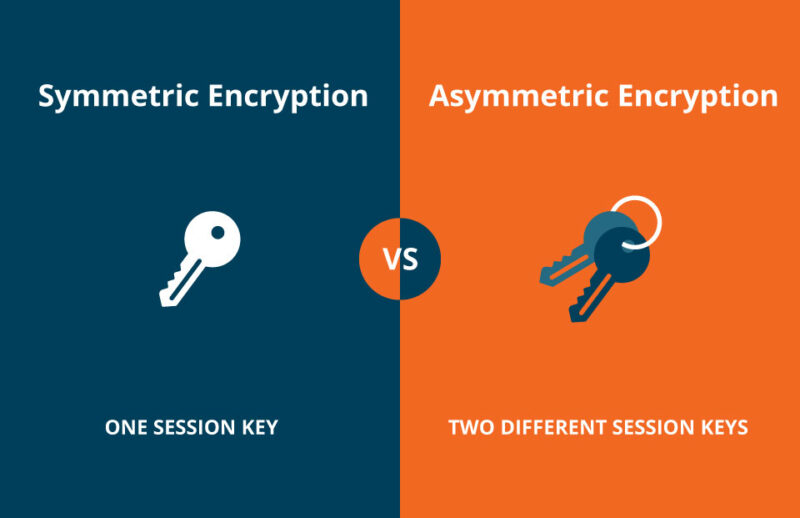In the digital age, the importance of data security cannot be overstated. As we increasingly rely on electronic means to communicate, transact, and store information, the need to protect this data becomes paramount. Enter the world of encryption, a method by which information is converted into a secret code to hide its true meaning.
But not all encryption is created equal. In this article, we’ll get into the two primary types of encryption: symmetric and asymmetric. By the end, you’ll have a comprehensive understanding of their differences, strengths, and weaknesses.
Before diving into the specifics, let’s first establish a foundational understanding of encryption. At its core, encryption is the process of converting plaintext (readable data) into ciphertext (encoded data). To revert the ciphertext back to its original form, one would need a key and a decryption process.
One Key to Rule Them All

Symmetric encryption, often termed as private-key or secret-key encryption, is a method where a single key is employed for both the encryption (converting readable data into a code) and decryption (reverting the code back to its original form) processes.
How It Works
To better grasp the concept, visualize a treasure chest. This chest holds valuable information, and there’s only one unique key that can lock or unlock it. In the realm of symmetric encryption, the treasure inside represents our data, while the unique key symbolizes the encryption key. If you wish for another person to view the treasure (data), you’d have to trust them with the key. However, this trust comes with its own set of challenges.
In-Depth Look
When two parties, say Alice and Bob, want to communicate securely using symmetric encryption, they both need access to the same secret key. This key will be used by Alice to encrypt her message and by Bob to decrypt it. The challenge arises when Alice needs to share this key with Bob without anyone else intercepting it. This act of securely sharing the key is often likened to the proverbial “chicken and egg” problem in cryptography.
Strengths:
- Speed: One of the primary advantages of symmetric encryption is its speed. Algorithms like AES (Advanced Encryption Standard) or DES (Data Encryption Standard) are designed to process large chunks of data swiftly. This makes symmetric encryption ideal for tasks that handle vast amounts of data in real-time.
- Simplicity: The mechanics behind symmetric encryption are relatively straightforward. With just one key to manage, the implementation becomes less complex, making it a preferred choice for many applications.
Weaknesses:
- Key Distribution: The Achilles’ heel of symmetric encryption is the secure distribution of the key. If Alice wants to send an encrypted message to Bob, they both need the same key. But how does Alice send this key to Bob without someone else intercepting it? This dilemma is a significant challenge in symmetric encryption.
- Scalability: Imagine a scenario with hundreds of users in a network, each needing to communicate securely with every other user. The number of unique keys required in such a setup using symmetric encryption becomes impractical. For instance, in a network of 100 users, 4,950 unique keys would be needed!
A Tale of Two Keys
Asymmetric encryption, standing in contrast to its symmetric counterpart, employs two separate keys: one public and one private. The public key, as the name suggests, is open for anyone to see and use. However, the private key remains confidential.
How It Works
Imagine a special mailbox that anyone can drop letters into, but only the owner can open and read. The act of dropping letters is akin to encrypting data using the public key, while the act of opening the mailbox and reading the letters is like decrypting with the private key.

In-Depth Look
When Alice wants to send a secure message to Bob using asymmetric encryption, she uses Bob’s public key to encrypt the message. Once encrypted, only Bob’s private key can decrypt and read the message. This ensures that even if someone intercepts the message, they cannot decipher its contents without the private key.
Strengths:
- Security: The beauty of asymmetric encryption lies in its security. Even if a malicious actor gets hold of the public key, they cannot decrypt the data. The private key, which remains confidential, is essential for decryption.
- Key Distribution: Unlike symmetric encryption, there’s no need to secretly share keys. The public key can be openly distributed without any security risks.
- Digital Signatures: Beyond encryption, asymmetric methods enable the creation of digital signatures. This feature ensures the authenticity of a message, confirming it came from the claimed sender and remains unaltered.
Weaknesses:
- Speed: The strength of asymmetric encryption comes at a cost: speed. The complex mathematics behind the dual-key system makes it slower, especially when handling large data volumes.
- Complexity: Implementing asymmetric encryption requires a deeper understanding of cryptographic principles, making it more intricate than symmetric methods.
Real-world Applications

Symmetric Encryption:
- File Encryption: Whether it’s a single document or an entire hard drive, symmetric encryption ensures data remains confidential.
- Secure Socket Layer (SSL): This protocol, foundational to web security, employs symmetric encryption to safeguard data during its journey across the internet.
Asymmetric Encryption:
- Emails: Services like PGP (Pretty Good Privacy) use asymmetric encryption to ensure only the intended recipient reads an email.
- Digital Certificates: When you see a padlock symbol in your browser’s address bar, it’s a sign of SSL/TLS, which uses asymmetric encryption to authenticate websites.
Which is Better?

Choosing between symmetric and asymmetric encryption isn’t a matter of superiority but suitability. Symmetric methods excel in speed and simplicity, ideal for real-time data-heavy tasks. On the other hand, asymmetric encryption, with its robust security and key distribution features, is perfect for secure communications over untrusted networks. The decision hinges on the specific requirements of the task at hand.
FAQs
Why is symmetric encryption considered less secure than asymmetric encryption for transmitting data over the internet?
While symmetric encryption itself is secure, the primary vulnerability arises from the key distribution process. When transmitting data over the internet, there’s a risk that the shared secret key might be intercepted by malicious actors. In contrast, asymmetric encryption doesn’t require the private key to be transmitted, making it inherently more secure for online data transmission.
Can symmetric and asymmetric encryption be used together?
Absolutely! In fact, many secure communication protocols use a combination of both. For instance, during an SSL/TLS handshake, asymmetric encryption is initially used to securely exchange a symmetric key. Once both parties have the symmetric key, they switch to symmetric encryption for faster data transmission.
How are the keys generated in asymmetric encryption?
In asymmetric encryption, keys are generated using complex mathematical algorithms that ensure the two keys (public and private) are related. Common algorithms for key generation include RSA (Rivest–Shamir–Adleman) and ECC (Elliptic Curve Cryptography). The exact process involves intricate mathematical procedures that ensure the security and uniqueness of each key pair.
What happens if I lose my private key in asymmetric encryption?
Losing your private key is a significant concern. If it’s lost and you don’t have a backup, any data encrypted with its corresponding public key will be irretrievable. Moreover, if someone else gains access to your private key, they can decrypt messages meant for you or impersonate you in digital communications. It’s crucial to keep private keys secure and backed up.
Are there any notable examples of symmetric encryption algorithms?
Yes, some of the most renowned symmetric encryption algorithms include AES (Advanced Encryption Standard), DES (Data Encryption Standard), and 3DES (Triple DES). Among these, AES is widely regarded as the most secure and is adopted as a standard by many organizations globally.
How do digital signatures in asymmetric encryption prove the authenticity of a sender?
Digital signatures use the private key of the sender to create a unique signature for a message. When the recipient receives the message, they can use the sender’s public key to verify the signature. If the signature matches, it confirms that the message has not been tampered with and indeed originates from the claimed sender.
Conclusion
In the vast realm of data security, understanding the nuances between symmetric and asymmetric encryption is crucial. While both have their place in the world of cybersecurity, their unique strengths and weaknesses make them suitable for different applications.
As we continue to advance in the digital age, the importance of encryption and the knowledge surrounding it will only grow. Whether you’re a tech enthusiast, a cybersecurity professional, or just a curious mind, we hope this article has shed light on this intricate topic.






